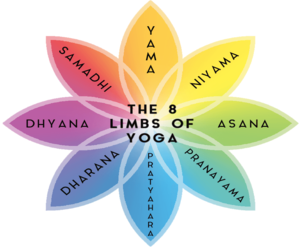The benefits of yoga affect each person in a different way. Many think this makes them relax; others feel happier and more energetic. All of the systems in the body-from lymphatic to digestive to yoga cardiovascular benefit. Yoga benefits every dimension, within and outside of our bodies.
Ashtanga translates as 8 limbs. Asta meaning eight, and the limb meaning Anga. Ashtanga is the ancient yoga system mentioned in the Yoga Sutras of Patanjali.
The impurities of body and mind will be eliminated by the practice and knowledge of all eight limbs . While the limbs should be approached separately and step by step, they should be connected together actively and allowed to grow simultaneously in action.
- Yamas: abstinences
- Niyamas: observances
- Asana: posture
- Pranayama: breath expansion
- Pratyahara: sense withdrawal
- Dharana: concentration
- Dhyana: meditation
- Samadhi: absorption
Ashtanga’s eight limbs can also be categorized as Hatha yoga, and Raja yoga. Hatha yoga consists of the first five limbs, which are externally oriented and purify and stabilize the practitioner’s body, nervous system, and mind.
01. YAMAS
Five yamas control our inner actions and hence how we communicate with the outside world.The five Yamas are ahimsa (non-violence), satya (truthfulness), asteya (not stealing), brahmacharya (moderation) and aparigraha (not hoarding).
02. NIYAMAS
Niyama is the second limb of yoga, There are 5 niyamas that function as the ideals we communicate with ourselves with. They are pureness, contentment, self-discipline, self-study and Divine devotion.
- Sauca -Purity. Maintaining inner and outer purity by keeping the mind, body and environment clear and clean.
- Santosha – contentment: To be happy with what we’ve received, which leads to inner joy.
- Tapas – self discipline. Through tapas, the body and the senses are purified, resulting in clarity and spiritual strength..
- Svadhyaya – self study.
- Isvara pranidhana – devotion to the Divine.
03. ASANA
Asana means sitting comfortably and steadily and the third limb of the 8-limbed path of yoga as prescribed by Patanjali.
04. PRANAYAMA: BREATH CONTROL
By controlling the breath the mind comes under our control. Pranayama is the fourth limb of the eight-limbed yoga path and means life / energy preservation or expansion
Pranayama are breathing exercises that clear our body’s physical and emotional part. You can overcharge your entire body by daily and continuous pranayama practices
05. PRATYAHARA
Pratyahara is the fifth yoga limb, which is the process of separating the senses from the outside world. Through this yoga practitioners increases the inner awareness
Pratyahara is considered important in yoga because it makes an bridge between the external focus of the previous limbs of yoga and the internal focus of the subsequent limbs, which help the practitioner into concentration, meditation and, eventually, to reach the goal of samadhis
06. DHARANA: ONE POINTED CONCENTRATION
Dharana, the sixth yoga limb, is “holding,” or concentration, and refers to being able to concentrate completely on one thing.to get the subconscious mind completely under control.
07. DHYANA: MEDITATION
Dhyana is the seventh of the 8 limbs of yoga. Complete concentration with out any disturbing taught and the deeper level of meditation
08. SAMADHI
Samadhi is the final of the 8 yoga limbs in which the meditating individual merges with the meditative entity.


Leave a Reply